latest Reviews and articles
CHAMPAGNE DEUTZ – THE QUIET PLAYER ON THE WORLD STAGE - Within the UK Deutz Champagne is considered one of Champagnes...
Where to celebrate Bastille Day in London - Many restaurants and bars in London have chosen to embrace...
How do you chose a dentist in London? - There are so many dentists in London. How do I choose?
The Brioche de Noel Pasquier arrives in London at last - In this festive season, there will be many food options to enjoy...
MAGAZINE
-
 Children
Children
-
 Culture
Culture
-
 Decoration
Decoration
-
 Economy/Politics
Economy/Politics
-
 Education
Education
-
 Fashion
Fashion
-
 Food / Wine
Food / Wine
-
 Health
Health
-
 Holidays
Holidays
-
 Jobs
Jobs
-
 Law
Law
-
 Life and Style
Life and Style
-
 Property
Property
-
 Sport
Sport
Device converter
Weather
Classified ads
- House to Rent - Barn Hill - Near Lycee
- Tax Return MN | Prudent Accountants
- 3 bedroom flat to rent
- Football agent looking for talented players
Recently added
articles > Sport events

Cricket for (French) dummies
.jpg)
An addiction to the X Factor and a passion for cricket. These are the two main 'cultural' phenomenons that have astonished me in English people since I arrived in London three months ago. In France, Simon Cowell would never be given two pages in the newspapers each week, and cricket remains, for most French people, an insect (it means grasshopper). As we near the X Factor's final and with the Ashes, international cricket's most celebrated series, starting recently, my sense of cultural confusion has only increased.
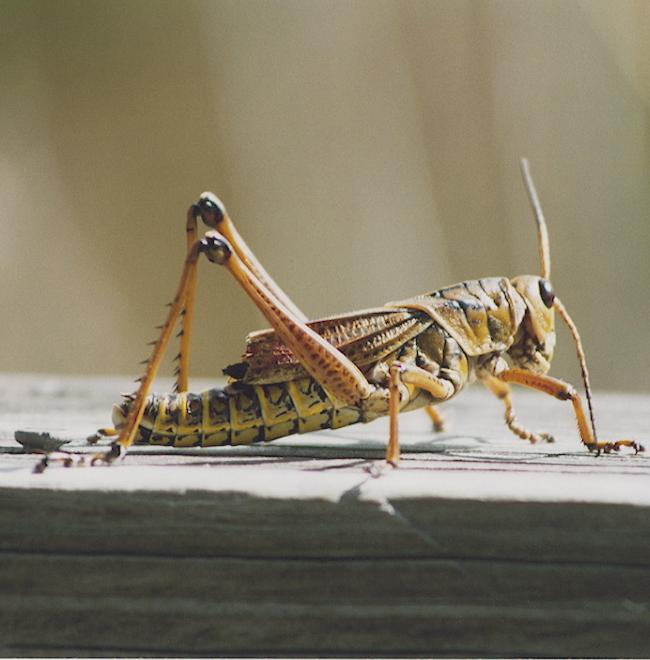
As it is substantially more difficult to understand the rules of a cricket match than those of the X Factor, I decided to look into the laws of this baseball-alike sport, very popular in the Commonwealth, an share my newly-acquired knowledge with my fellow cofused French expatriates. I feel that a concept of the basic rules will be necessary to avoid feeling totally left out during the next three months, as the Ashes will hold the British population until January 2011. I will try to make myself clear, but if you have any question - or objection, (eh, I am French, so forgive my possible mistakes)- feel free to post a comment.
Last point : of course, there are many other cricket rules. I have, however, chosen to stick to the basics (baby-steps) as many of the more advanced rules are not vital to play. Hopefull it will help you to enjoy a sport played in one hundred and twenty countries around the globe.
Bluff your way into a cricket conversation with some impressive tryvia:
As you may know, cricket is a long-running sport steeped with history. So I thought I would give you a few key dates to help bluff your way in a coversation and impress your English friends.
-
1611 : This is the first reference to cricket as a sport in its own right. Two men in Sussex were prosecuted for playing cricket on Sunday instead of going to church. At this time, cricket was not a religion... yet.
-
1709 : The first known game in which teams 'officially' use county names. But these sort of fixtures were undoubtedly arranged long before that.
-
1744 : While cricket was developing around the world through colonization, the Laws of Cricket were codified for the first time.
-
1844 : The first ever international cricket game was between the USA and Canada.

-
1975 : The first Cricket World Cup contest was organised in England.
-
2010 : A French adventurer sets off to explore the rules of this sport, unknown to Gallic citizen.
The game :
What's the aim of the game? :
- Cricket is played between two teams made up of eleven players each.
- Team A will bat first and try to score as many points as possible while team B will bowl and field to make it as hard as possible for the batting team to score.
- The teams then sweep over so team B try to beat score set by team A.
- The winning team is the one which scores the more points – called runs.
Now let's have a look at the main aspects of playing the game, with Team A is 'batting' and Team B 'bowling and fielding'.

Team A :
-
Batting and Scoring runs :
-The aim of batting is to score runs.
-Two players from team A are one the field at the same time.
-
One is called the striker : he stands on the opposite end of the pitch to the bowler (from team B)
waiting to receive the ball while the other batter, the 'non-striker' is next to the bowler, readyto run if the striker hits the ball with the bat.
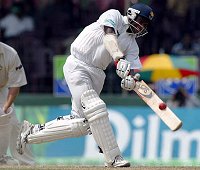 A batter
A batter - The striker aims to hit the ball as far as possible and runs to the wicket to the opposite end of the pitch to score one run.
- If a batter hits the ball far enough, he may run between the stumps more than once to score more runs.
- If a batter hits the ball out of the playing area without the ball bouncing, six runs are automatically scores. If the ball bounces or rolls on its way out of the field then 4 runs are scored.
- The runner then become the striker.
Team B :
-
Bowling :
- A bowler's main objective is to try to get the batter out by hitting the wicket and to make it as difficult as possible for the batter to score runs.
- He throws the ball as quickly as he can so that as the batter has little or no time to see it, he may miss the ball which can hit the wicket.
- But the bowler can also tricks the batter into making a mistake by bowling the ball slowly through the air and make it spin when it bounces.
A bowler will bowl six balls at the time. It's called an 'over'. And then it will be his team-mate's turn to bowl.
-
Fielding :
- Fielding is the job of the bowler's team-mates.
- The fielders stand where the batter is the most likely to hit the ball.
-
They try to prevent the batter from scoring by stopping
the ball as quickly as possible when it has been hit and field it back to the bowler.
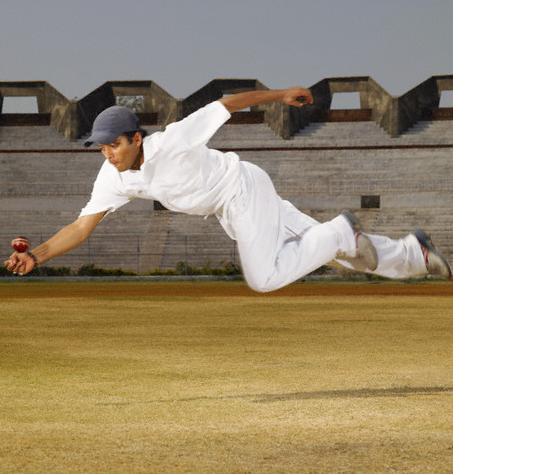 As Franck Sinatra said : "Fly me to the ball"
As Franck Sinatra said : "Fly me to the ball" - Their goal is then to throw it back to the wicket-keeper, a specialist fielder crouching behind the wickets at the opposite hand to the bowler.
- If the batter is not in his crease (a sort of safe-zone) when the wicket-keeper receives the ball, then the batter will be out.
- Fielders can also get the batter out by catching the ball before it hits the ground. This spectacular play is called 'catching'.
Team A can continue to bat until 10 of its 11 batters are out (as two batters are needed on the pitch at any time). Then it is team B's turn to try to beat the score.
Types of matches :

- The traditional form of cricket - like the Ashes - is called "Test Cricket".
- This game spans over two innings. This means that one team needs to bowl the other team out twice and score more runs than them to win the match.
- Test matches are played over five days, with six hours of play each day.
- Each day's play is divided into three sessions of two hours each, with a 40 minute break between the first two session for lunch, and a 20 minute tea break between the last two sessions.
- Play usually goes from 11:00 local time to 18:00, although this may be varied if sunset occurs early.
- In a nutshell : it is never-ending !
However there are other formats of games, like the one-day cricket, which differs significantly from first class cricket. As the name suggests, a one-day match is played on a single day. Usual choices for the number of overs are 50, 55, or 60. Recently, an abbreviated form of the games has been developed called Twenty20, with a maximum of 20 overs per innings.
Cricket's language :
Here are some terms you need to be familiar with to improve your knowledge of the rules of cricket.
-
The field : it is a roughly elliptical field of flat grass, ranging in size from about 90 to 150 metres (100-160 yards) across, bounded by an obvious fence. In the centre of the field is the pitch, there is a carefully prepared rectangle of hard packed earth.
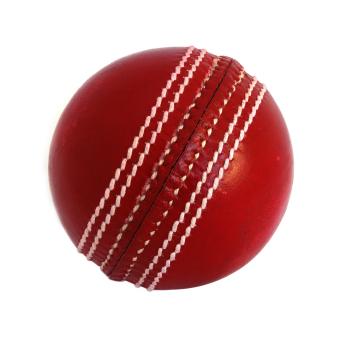
-
Cricket Ball: hard, cork and string ball, covered with thick leather. A bit like a baseball (in size and hardness). The circumference is between 224 and 229 millimetres (8.81 to 9.00 inches), and the ball weighs between 156 and 163 grams (5.5 to 5.75 ounces). Traditionally the ball is dyed red, with the stitching left white. But as cricket had to adapt to TV demands, white balls are also used, for visibility in games played at night under artificial lighting.
-
Cricket Bat: this blade made of willow, flat on one side, humped on the other for strength, is attached to a sturdy cane handle. It has a maximum width of 108 millimetres (4.25 inches) and the whole bat cannot exceed a length of 965 millimetres (38 inches).
-
Wickets: a crucial notion as this is why cricket differs from baseball. Two wickets - wooden structures are located at each end of the pitch. A wicket is made up by three stumps, (wooden posts of 25 millimetres (1 inch) in diameter and 813 millimetres (32 inches) high) which are close enough together so that a cricket ball cannot pass between them. On top of that, two wooden crosspieces are just resting on the stumps : they are the bails.
The Cricket Uniform :
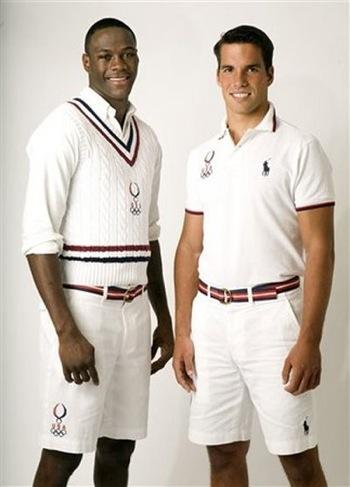
You may have noticed that the cricket uniform is regulated :
-
Protective Gear: pads, gloves, helmet, for batsmen to wear to prevent injury when struck by the ball.
-
Shoes: Leather, usually with spiked soles for grip on the grass.
-
Clothing: Long pants, shirt (long or short sleeved depending on the weather), possibly a sleeveless or long-sleeved woollen pullover in cold weather. And don't forget : add a hat or cap to keep the sun off. As a cricket match may go on for 5 days, you could have a sunburn !
Now you have all the information you need to watch- and maybe even enjoy- the Ashes with your friend! A match is admittedly quite long and unspectacular, but with one (or several) Guiness, cricket is definitely a fun sport to watch !



COMMENTS:
17/12/2015 - david.bordes said :
Si vous souhaitez vous essayer au cricket ou soutenir l'équipe de France de cricket et aider au développement du cricket en France, Merci d'en parler autour de vous.
David BORDES
Directeur Sportif de France Cricket
www.francecricket.com
22/08/2014 - jphdesmarest said :
salut, merci pour les explications !
Juste une petite erreur (je pense), c'est juste ma logique et compréhension de ton post qui me font penser que tu as écris 'lanceur' à la place de 'batteur' dans la ligne suivante (ou alors j'ai rien compris ! ;)) :
"Les receveurs peuvent également éliminer le lanceur : en attrapant la balle « au vol »"
Non?
JP
28/08/2013 - sylv.kp said :
Merci bien pour ces explications très claires. Je vis depuis peu avec un anglais pationné de cricket et je n'y comprends rien.
12/06/2011 - olfa.mzati said :
Bonjour, je suis une Française installée depuis presqu'un an à Londres et je pratique le cricket l'Oval et vais voir des matches au Lord's... j'adore ce sport! J'ai même rencontré Andrew Strauss, l'un des capitaines de l'équipe nationale!J'espère que quelques Français auront envie d'y jouer et qu'il y aurait une équipe pour la Sunday league!
LEAVE A COMMENT